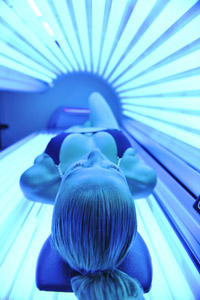UVA dermatologist Mark Russell, MD, contributed this post.
The sun is out, pools are open and summer is upon us. This may be the time that you think about using a tanning bed to get a jump on a summer tan. However, you may want to grab your sunscreen instead.
For years, the American Academy of Dermatology has opposed indoor tanning and continues to educate the public on the risks. The Food and Drug Administration (FDA) announced stricter regulation of tanning beds used by millions of Americans.
New restrictions include:
- A strong recommendation against the use of tanning beds by minors under the age of 18.
- The reclassification for sunlamps and tanning beds to a Class II level, meaning they pose a moderate risk, and the FDA has more ability to regulate them.
- Labeling that clearly communicates the risk of skin cancer to all users. Under the final changes, manufacturers will be required to provide updated labeling for all products on the market within 450 days of June 2, 2014.
There is No Safe Tan
Despite claims of “safe tanning” and “no harmful rays,” tanning beds are harmful to the skin, emitting ultraviolet radiation (UVR). According to the British Medical Journal, the United States Department of Health and Human Services and the World Health Organization have classified the whole ultraviolet spectrum and indoor tanning devices as carcinogenic to humans. Rays emitted from tanning beds can also cause premature aging of the skin.
Indoor Tanning Increases Cancer Risk
One of the main reasons for the new regulations is that indoor tanning increases the risk of developing skin cancer, especially for those exposed to UVR at an early age. Research indicates that indoor tanning before age 35 increases your chance of developing melanoma by 59-75 percent. If you tan indoors before age 25, your non-melanoma skin cancer risk increases by 40-102 percent.
Melanoma incidence rates are steadily increasing, especially among young non-Hispanic white females, which may be due, in part, to indoor tanning. It is one of the most deadly types of cancer if found in stage three or later.
Concerned about skin cancer?
Learn more about skin cancer symptoms.
We recommend taking action quickly and seeing a dermatologist if you notice any suspicious spots on your skin. We have dermatology clinics in Charlottesville, Waynesboro, Culpeper, and Zion Crossroads.
If you have a history of skin cancer, including melanoma, see what UVA Health can do for you.
